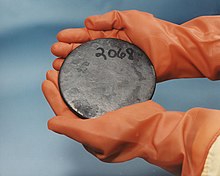Uranium-235
 Uranium metal highly enriched in uranium-235 | |
| General | |
|---|---|
| Symbol | 235U |
| Names | uranium-235, 235U, U-235 |
| Protons(Z) | 92 |
| Neutrons(N) | 143 |
| Nuclide data | |
| Natural abundance | 0.72% |
| Half-life(t1/2) | 703800000years |
| Isotope mass | 235.0439299Da |
| Spin | 7/2− |
| Excess energy | 40914.062±1.970keV |
| Binding energy | 1783870.285±1.996keV |
| Parent isotopes | 235Pa 235Np 239Pu |
| Decay products | 231Th |
| Decay modes | |
| Decay mode | Decay energy(MeV) |
| Alpha | 4.679 |
| Isotopes of uranium Complete table of nuclides | |
Uranium-235(235
U
orU-235) is anisotope of uraniummaking up about 0.72% ofnatural uranium.Unlike the predominant isotopeuranium-238,it isfissile,i.e., it can sustain anuclear chain reaction.It is the only fissile isotope that exists in nature as aprimordial nuclide.
Uranium-235 has ahalf-lifeof 703.8 million years. It was discovered in 1935 byArthur Jeffrey Dempster.Itsfission cross sectionfor slowthermal neutronsis about584.3±1barns.[1]Forfast neutronsit is on the order of 1 barn.[2] Mostneutron absorptionsinduce fission, though a minority (about 15%) result in the formation ofuranium-236.[3][4]
Fission properties
[edit]
The fission of one atom of uranium-235 releases202.5 MeV(3.24×10−11J) inside the reactor. That corresponds to 19.54 TJ/mol,or 83.14 TJ/kg.[5]Another 8.8 MeV escapes the reactor as anti-neutrinos. When235
92Unuclei are bombarded with neutrons, one of the many fission reactions that it can undergo is the following (shown in the adjacent image):
Heavy water reactorsand somegraphite moderated reactorscan use natural uranium, butlight water reactorsmust uselow enriched uraniumbecause of the higherneutron absorptionof light water.Uranium enrichmentremoves some of the uranium-238 and increases the proportion of uranium-235.Highly enriched uranium(HEU), which contains an even greater proportion of uranium-235, is sometimes used in the reactors ofnuclear submarines,research reactorsandnuclear weapons.
If at least oneneutronfrom uranium-235 fission strikes another nucleus and causes it to fission, then the chain reaction will continue. If the reaction continues to sustain itself, it is said to becritical,and the mass of235U required to produce the critical condition is said to be a critical mass. A critical chain reaction can be achieved at low concentrations of235U if the neutrons from fission aremoderatedto lower their speed, since the probability for fission withslow neutronsis greater. A fission chain reaction produces intermediatemass fragmentswhich are highlyradioactiveand produce further energy by theirradioactive decay.Some of them produce neutrons, calleddelayed neutrons,which contribute to the fission chain reaction. The power output ofnuclear reactorsis adjusted by the location ofcontrol rodscontaining elements that strongly absorb neutrons, e.g.,boron,cadmium,orhafnium,in the reactor core. Innuclear bombs,the reaction is uncontrolled and the large amount ofenergyreleased creates anuclear explosion.
Nuclear weapons
[edit]TheLittle Boygun-typeatomic bomb dropped on Hiroshima on August 6, 1945, was made of highly enriched uranium with a largetamper.The nominal spherical critical mass for an untampered235U nuclear weapon is 56 kilograms (123 lb),[6]which would form a sphere 17.32 centimetres (6.82 in) in diameter. The material must be 85% or more of235U and is known asweapons gradeuranium, though for a crude and inefficient weapon 20% enrichment is sufficient (calledweapon(s)-usable). Even lower enrichment can be used, but this results in the requiredcritical massrapidly increasing. Use of a large tamper,implosiongeometries, trigger tubes,poloniumtriggers,tritiumenhancement, andneutron reflectorscan enable a more compact, economical weapon using one-fourth or less of the nominal critical mass, though this would likely only be possible in a country that already had extensive experience in engineering nuclear weapons. Most modern nuclear weapon designs useplutonium-239as the fissile component of the primary stage;[7][8]however, HEU (highly enriched uranium, in this case uranium that is 20% or more235U) is frequently used in the secondary stage as an ignitor for the fusion fuel.
| Source | Average energy released [MeV][5] |
|---|---|
| Instantaneously released energy | |
| Kinetic energy of fission fragments | 169.1 |
| Kinetic energy of prompt neutrons | 4.8 |
| Energy carried by prompt γ-rays | 7.0 |
| Energy from decaying fission products | |
| Energy of β− particles | 6.5 |
| Energy of delayed γ-rays | 6.3 |
| Energy released when those prompt neutrons which do not (re)produce fission are captured | 8.8 |
| Total energy converted into heat in an operating thermal nuclear reactor | 202.5 |
| Energy of anti-neutrinos | 8.8 |
| Sum | 211.3 |
Natural decay chain
[edit]
Uses
[edit]Uranium-235 has many uses such as fuel for nuclear power plants and in nuclear weapons such asnuclear bombs.Someartificial satellites,such as theSNAP-10Aand theRORSATswere powered by nuclear reactors fueled with uranium-235.[9][10]
References
[edit]- ^"#Standard Reaction: 235U(n,f)".www-nds.iaea.org.IAEA.Retrieved4 May2020.
- ^""Some Physics of Uranium",UIC.com.au".Archived from the original on July 17, 2007.Retrieved2009-01-18.
{{cite web}}:CS1 maint: unfit URL (link) - ^"Capture-to-fission Ratio".nuclear-power.com.RetrievedJune 26,2024.
- ^Cabell, M. J.; Slee, L. J. (1962). "The ratio of neutron capture to fission for uranium-235".Journal of Inorganic and Nuclear Chemistry.24(12): 1493–1500.doi:10.1016/0022-1902(62)80002-5.
- ^abNuclear fission and fusion, and neutron interactions,National Physical Laboratory Archive.
- ^"FAS Nuclear Weapons Design FAQ".Archived fromthe originalon 1999-05-07.Retrieved2010-09-02.
- ^Nuclear Weapon Design.Federation of American Scientists. Archived fromthe originalon 2008-12-26.Retrieved2016-06-04.
- ^Miner, William N.; Schonfeld, Fred W. (1968)."Plutonium".In Clifford A. Hampel (ed.).The Encyclopedia of the Chemical Elements.New York (NY): Reinhold Book Corporation. p.541.LCCN68029938.
- ^Schmidt, Glen (February 2011)."SNAP Overview – radium-219 – general background"(PDF).American Nuclear Society.Retrieved27 August2012.
- ^"RORSAT (Radar Ocean Reconnaissance Satellite)".daviddarling.info.
External links
[edit]- Table of Nuclides.
- DOE Fundamentals handbook: Nuclear Physics and Reactor theoryVol. 1Archived2017-07-31 at theWayback Machine,Vol. 2Archived2016-12-20 at theWayback Machine.
- Radionuclide Basics: Uranium | US EPA
- NLM Hazardous Substances Databank – Uranium, Radioactive
- "The Miracle of U-235",Popular Mechanics,January 1941—one of the earliest articles on U-235 for the general public

![{\displaystyle {\begin{array}{r}{\ce {^{235}_{92}U->[\alpha ][7.038\times 10^{8}\ {\ce {y}}]{^{231}_{90}Th}->[\beta ^{-}][25.52\ {\ce {h}}]{^{231}_{91}Pa}->[\alpha ][3.276\times 10^{4}\ {\ce {y}}]{^{227}_{89}Ac}}}{\begin{Bmatrix}{\ce {->[98.62\%\beta ^{-}][21.773\ {\ce {y}}]{^{227}_{90}Th}->[\alpha ][18.718\ {\ce {d}}]}}\\{\ce {->[1.38\%\alpha ][21.773\ {\ce {y}}]{^{223}_{87}Fr}->[\beta ^{-}][21.8\ {\ce {min}}]}}\end{Bmatrix}}{\ce {^{223}_{88}Ra->[\alpha ][11.434\ {\ce {d}}]{^{219}_{86}Rn}}}\\{\ce {^{219}_{86}Rn->[\alpha ][3.96\ {\ce {s}}]{^{215}_{84}Po}}}{\begin{Bmatrix}{\ce {->[99.99\%\alpha ][1.778\ {\ce {ms}}]{^{211}_{82}Pb}->[\beta ^{-}][36.1\ {\ce {min}}]}}\\{\ce {->[2.3\times 10^{-4}\%\beta ^{-}][1.778\ {\ce {ms}}]{^{215}_{85}At}->[\alpha ][0.10\ {\ce {ms}}]}}\end{Bmatrix}}{\ce {^{211}_{83}Bi}}{\begin{Bmatrix}{\ce {->[99.73\%\alpha ][2.13\ {\ce {min}}]{^{207}_{81}Tl}->[\beta ^{-}][4.77\ {\ce {min}}]}}\\{\ce {->[0.27\%\beta ^{-}][2.13\ {\ce {min}}]{^{211}_{84}Po}->[\alpha ][0.516\ {\ce {s}}]}}\end{Bmatrix}}{\ce {^{207}_{82}Pb_{(stable)}}}\end{array}}}](https://wikimedia.org/api/rest_v1/media/math/render/svg/da2e321e70c54cd68c88b0abb6a8286b29b18b5a)